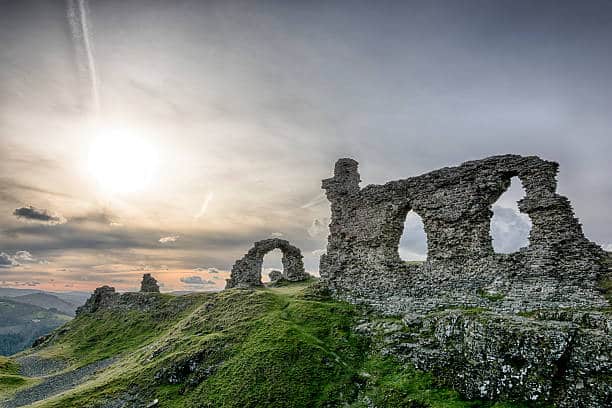“I broke my heart in five pieces
And buried a part by the sea
And I hid a part in the mountains
And the third in the root of a tree,
And the fourth I gave to a singer
Who share his wild ecstasy,
But the best I gave to a woman
Who gave all her heart to me.”
Idris Davies (1905-1953)
Wales isn’t just the land of the song. The Celtic nation is also home to some of the most romantic (and sometimes heart-wrenching!) legends, many of them stemming from here in North Wales. The Welsh hills are steeped in the history of both love and war, and this post will bring to light some of the most legendary tales.
Buckle up for some budding stories of love, lust – and as with any indigenous legends, pain and anguish. But because it’s Valentine’s Day, we promise to big up the best bits and leave out the sad parts. Read on to discover the most romantic tales of North Wales…
1. Santes Dwynwen, Patron Saint of Love, and Maelon

Date: 5th century
Where to take a romantic stroll: Llanddwyn Island, Anglesey
We couldn’t write a feature on romance in Wales and not start with the patron saint of love, could we? This well-known legend dates back to the 5th century Anglesey, focusing on protagonist Dwynwen. The prettiest of Brychan Brycheiniog’s (the King of Powys’) 24 daughters, Dwynwen fell in love with the dashing Maelon Dafodrill.
Here is the first of our ‘forbidden love’ stories: The King had already arranged for his daughter Dwynwen to marry someone else, and forbade this union. She was distraught by this and in her anguish, begged that God made her forget her beloved Maelon. An angel then visited her in a dream bearing a potion that would clear her memory, and turn her love into a block of ice. Upon awakening, Dwynwen was horrified and begged the angel to bring the chilly Maelon back to life.
This was her first of three wishes granted by God. Her second was that all hopes and dreams of lovers in the land be met; her third, that she will never marry. She devoted her life to God in return for these wishes being granted and founded a convent in his name.
This convent on Llanddwyn, off the west coast of Anglesey, is home to a special well that became a pilgrim destination after Dwynwen died in 465AD. Visitors believe the sacred fish in the well predict whether or not a relationship will last. Lovelorn tourists still cast their wishes into this well, hoping Saint Dwynwen will take pity on their unrequited plight.
To this day, Dwynen remains the patron saint of love and her memory is celebrated on January 25th. This is considered as the Welsh Valentine’s Day, and lovers often swap love spoons or other romantic gifts.
2. ‘Chwedl’ Rhys and Meinir

Date: Before they had calendars
Go and visit: Yr Eifil, Nant Gwrtheyrn, Llyn Peninsula
The most tragic love story of Wales is set in the secluded vale of Nant Gwrtheyrn, on the Llyn Peninsula. This tells the tale of two young lovers, Rhys & Meinir, who were childhood sweethearts and soon to be wed. Before their wedding in Clynnog Church on a Saturday, the townspeople came with gifts for the blossoming young couple and a sense of joy permeated the air for days.
It was custom for the people on each of the three farms in the Nant to uphold a valued tradition: ‘The Wedding Quest.’ This jest-fuelled mission consisted of the bride going off to hide, and the groomsmen searching for her. As per tradition, they would then bring her to the church in good spirits to be married before the groom.
The church was full of people when Meinir ran off to the hills, pursued by happy groomsmen. But hours went by with no sight of Meinir, and the hunters returned to the church full of fear. Rhys was distraught by this news, and spend all night searching for his bride. Days and months went by with no sign of the lady in white, and Rhys in his sorrow began to lose his mind.
A few months later, haunted with fright, he went to his and Meinir’s meeting spot beneath their favourite oak tree. A bolt of lightning suddenly struck the oak, splintering the thick wood in half. What was revealed between the sliced trunk would be the death of the lovelorn groom.
Inside the tree, adorned in a white wedding dress, was the skeleton of his beloved bride Meinir. She had hidden – albeit too well – and got stuck inside the oak. At this revelation, Rhys was overwrought with grief and died on the spot of a broken heart.
This tree still stands at the bottom of the Eifl, near Clynnog Church, and no bird but the owl or cormorant will land on it. Have you spotted the two lonely ghosts who wander hand in hand?
3. Myfanwy and Hywel’s Unrequited Love

Date: 14th century
Romantic place of inspiration: Castell Dinas Bran
Cue the violins for this ultra-romantic tale which has an abundance of Welsh heritage seeping through it. This tale is one that has inspired generations of music, art, and poetry, and it all begins at Castell Dinas Bran in Llangollen, Denbighshire. Here’s what we know:
- Myfanwy, daughter of the lord who ruled the house of Dinas Bran, was a beautiful young woman who attracted many suitors
- One day, the 14th-century poet Hywel ap Einion Llygliw clapped eyes on Myfanwy Fechan and fell in love
- Desperate for her hand in marriage, Hywel pursued Myfanwy with a burning, irrevocable love
- Myfanwy, born of noble heritage, rejected this layman poet for a richer, more handsome and more eloquent suitor (Goronwy Fychan ap Tudur)
- The lovelorn poet was distraught and decided to write a ballad conveying his loss and yearning, titled ‘Ode to Myfanwy Fychan of Castell Dinas Brân’. It went something like this:
“Oh fairer thou, and colder too; Than new-fallen snow on Arran’s brow; Oh lovely flower of Trevor race; Let not a cruel heart disgrace; The beauties of thy heavenly face! Thou art my daily thought each night; Presents Myfanwy to my sight.”
- This ode would have been in really old dialect, but it was translated into modern verse by Thomas Pennant a few years later
- Many centuries on in 1858, this original ode inspired Welsh poet John Ceiriog Hughes to compose a ballad for the Llangollen Eisteddfod. This ballad was received very well and praised by his peers and audience
- In that same century, composer Joseph Parry set music to lyrics written by Richard Davies. This formed the popular love-anthem of Wales we know today as ‘Myfanwy‘
4. Macsen and Elen

Date: Historical facts & Welsh folklore combined, so we’re not sure!
Where you can visit: Caernarfon Castle, Carmarthen Castle, Caerleon Castle
You can’t discuss Welsh folklore without mentioning The Mabinogion. The Mabinogion is a selection of tales written in Middle-Welsh and are the earliest recorded prose stories in Britain. Many patrons regard these tales as a literary heritage, which are adored and idolised for their offerings of drama, philosophy, romance, tragedy, fantasy and humour.
One of the stories in the Mabinogion series is ‘The Dream of Macsen Wledig.’ Macsen is the powerful Emperor of Rome, who one day when he was out hunting, had a dream of a faraway land. In this dream, he climbed a mountain and discovered the most beautiful realm he had ever seen. He followed a river, crossed a white whalebone bridge and climbed on board a magic ship that washed him ashore at an unknown destination.
Macsen was amazed by the beauty and fairness of everything around him as he explored this new land. He discovered a finely decorated castle, and inside, a dazzling hall. Sitting in this hall was the most overwhelmingly beautiful young maiden Macsen had ever seen. Her radiance was breathtaking, and the Emperor dreamt the pair were poised for a kiss.
When he woke up, a long time had passed and his troops grew concerned when he wouldn’t eat or drink. He began to waste away in bed, tormented by dreams of this fair young maiden he so loved. Eventually, he sent out armies across the whole world searching for his beauty. They came across mount Snowdon and saw the castle in the foothills like Macsen’s dream. They told the Emperor who marched overseas to the British Isles and approached the castle.
In the beautifully clad hall, he set eyes on the most beautiful woman he had ever seen with hair as radiant as gold. Her name was Elen, and they wed that very night. As a wedding present and a token of his vast love for the new Empress of Rome, Macsen built three huge castles for his new love: Caernarfon Castle, Carmarthen Castle, Caerleon Castle.


















